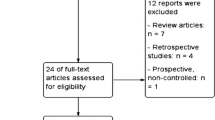Abstract
The purpose of this article is to update the debate on the impact of robotic surgery for pelvic organ prolapse with recent literature. Review of this subject will continue the analysis of the expansion of robotic surgery and its impact on the value and quality of pelvic organ prolapse surgery. Up until recently, this area of study was dominated by retrospective data with conflicting evidence. The quality of literature on the subject has improved in the past 5 years. Randomized control trials have started reporting results that are more consistent between studies. Additionally, high-quality patient data from a Nationwide Inpatient Sample database has been available since introduction of the robotic modifier code for robotic surgery in 2008. Meta-analyses examining the differences amongst studies will also be discussed. This article will review the literature and examine the debate on the impact of robotic surgery on cost, patient safety, outcomes, and training.
Similar content being viewed by others
References
Papers of particular interest, published recently, have been highlighted as: • Of importance •• Of major importance
Elliot, Hsieh MH, Sokol ER, Comiter CV, Payne CK, Chen B. Gynecologic use of robotically assisted laparoscopy: sacrocolpopexy for the treatment of high grade vaginal vault prolapse. The American Journal of Surgery 188 Oct. 2004
Journal of Healthcare Management 46L4 July/August 2003, intuitive surgical annual report 2012.
Li H, Sammon J, Roghmann F, Sood A, Ehlert M, Sun M, et al. Quoc-Dien utilization and perioperative outcomes of robotic vaginal vault suspension compared to abdominal or vaginal approaches for pelvic organ prolapsed. Can Urol Assoc J. 2014;8(3-4):100–6. This study compiled expansive population data and demographics for RSC in the United States.
Barbash GI, Glied S. New technology and health care costs—the case of robot-assisted surgery. N Engl J Med. 2010;363:701–4.
Anger JT, Mueller ER, Tarnay C, Smith B, Stroupe K, Rosenman A, et al. Robotic compared with laparoscopic sacrocolpopexy: a randomized controlled trial. Obstet Gynecol. 2014;123(1):5–12. This is the most recent RCT in RSC vs LSC powered to compare cost.
Paraiso MFR, Jelovsek JE, Frick A, Chen CC, Barber MD. Laparoscopic compared with robotic sacrocolpopexy for vaginal prolapse: a randomized controlled trial. Obstet Gyneco. 2011;118(5):1005–13. This was the first RCT done comparing RSC to LSC.
Hoyte L, Rabbanifard R, Mezzich J, Bassaly R, Downes K. Cost analysis of open versus robotic assisted sacrocolpopexy. Female Pelvic Med Reconstr Surg. 2012;18(6):335–9.
Tan-Kim J, Menefee SA, Luber KM, Nager CW, Lukacz ES. Robotic-assisted and laparoscopic sacrocolpopexy: comparing operative times, costs and outcomes. Female Pelvic Med Reconstr Surg. 2011;17(1):44–9. PubMed: 22453672.
Judd JP, Siddiqui NY, Barnett JC, Visco AG, Havrilesky LJ, Wu JM. Cost minimization analysis of robot-assisted and laparoscopic sacrocolpopexy: comparing operative times, cost and outcomes. Female Pelvic Med Reconstr Surg. 2011;17:44–9.
DeGouveia M, Leica SC, Whitlow B, Artahona M. Robotic versus laparoscopic sacrocolpopexy for treatment of prolapse of the apical segment of the vagina: a systematic review and meta-analysis. Int Urogynecol J. 2015. doi:10.1007/s00192-015-2763-0.
Serati M, Bogani G, Sorice P, Braga A, Torella M, Salvatore S, Uccella S, Cromi A, Ghezzi F Robotic sacrocolpopexy for pelvic organ prolapse: a systematic review and meta-analysis of comparative studies. European Urology March 2014 303-318
Unger CA, Paraiso MFR, Jelovsek JE, Barber MD, Ridgeway B. Perioperative adverse events after minimally invasive sacrocolpopexy. Am J Obstet Gynecol. 2014;211:547. e1-8.
Linder B, Chow G, Elliot D. Long term quality of life outcomes and retreatment rates after robotic sacrocolpopexy. Int J Urology. 2015. doi:10.1111/iju.12900.
Osmundsen BC, Clark A, Goldsmith C, Adams K, Denman MA, Edwards R, et al. Mesh erosion in robotic sacrocolpopexy. Female Pelvic Med Reconstr Surg. 2012;18:86–8.
Hudson CO, Northington GM, Lyles RH, Karp DR. Outcomes of robotic sacrocolpopexy: a systematic review and meta-analysis. Female Pelvic Med Reconstr Surg Mar. 2014;20(5):252–60.
Geller EJ, Lin FC, Matthews CA. Analysis of robotic performance times to improve operative efficiency. J Minim Invasive Gynecol. 2013;20(1):43–8. doi:10.1016/j.jmig.2012.08.774.
Shariati A, Maceda JS, Hale DS. Da Vinci assisted laparoscopic sacrocolpopexy: surgical technique on a cohort of 77 patients. J Pelvic Med Surg. 2008;14:163–71.
Lee RK, Mottrie A, Payne CK, Waltregny DA. Review of the current status of laparoscopic and robot-assisted sacrocolpopexy for pelvic organ prolapse. Eur Urol. 2014;65:1128–37.
Akl MN, Long JB, Giles DL, Cornella JL, Pettit PD, Chen AH, et al. Robot assisted sacrocolpopexy: technique and learning curve. Surg Endosc. 2009;23:2900–4.
Hach CE, Krude J, Reitz A, Reiter M, Hafekamp A, Buse S. Mid-term results of robotic sacrocolpopexy. Int Urogynecol. 2015;26:1321–6.
Ploumidis A, Spinoit AF, De Naeyer G, Shatteman P, Gan M, Ficarra V, Volpe A, Mottrie A Robot-assisted sacrocolpopexy for pelvic organ prolapse: surgical technique and outcomes at a single high-volume institution. Eur Urol 65(1):138–145
Lenihan Jr JP, Kovanda C, Seshari-kreaden U. What is the learning-curve for robotic assisted gynecologic surgery? J Minim Invasive Gynecol. 2008;15(5):589–94.
Geller EJ, Parnell BA, Dunivan GC. Pelvic floor function before and after robotic sacrocolpopexy: one year outcomes. J Minim Invasive Gynecol. 2011;18(3):322–7.
Bradley MS, Kantartzis KL, Lowder JL, Winger D, Wang L, Shepherd JP Adoption of robotic sacrocolpopexy at an academic instituition Journal of the Society of Laparoendoscopic Surgeons July-Sept 2014 18(3)
Author information
Authors and Affiliations
Corresponding authors
Ethics declarations
Conflict of Interest
Dr. Ng and Dr. Nealy declare that they have no conflict of interest.
Human and Animal Rights and Informed Consent
This article does not contain any studies with human or animal subjects performed by any of the authors.
Additional information
This article is part of the Topical Collection on Stress Incontinence and Prolapse
Rights and permissions
About this article
Cite this article
Ng, L., Nealy, S.W. Current Controversies in Robotic Prolapse Repair. Curr Bladder Dysfunct Rep 11, 61–65 (2016). https://doi.org/10.1007/s11884-016-0350-y
Published:
Issue Date:
DOI: https://doi.org/10.1007/s11884-016-0350-y




